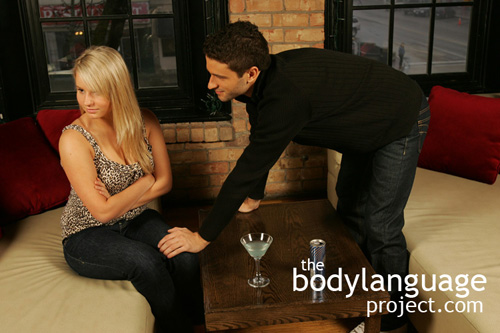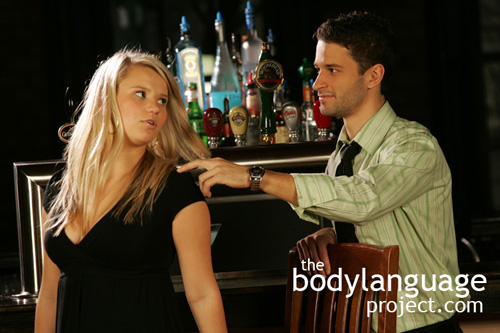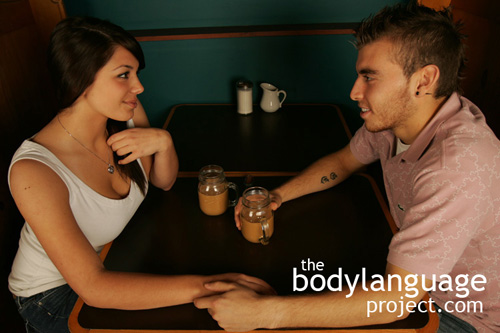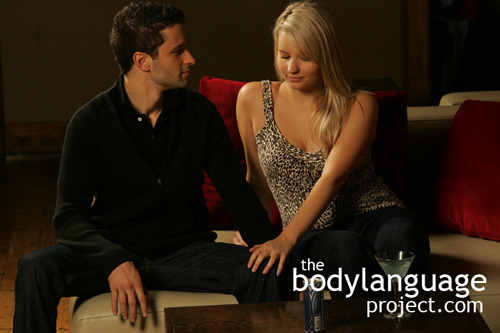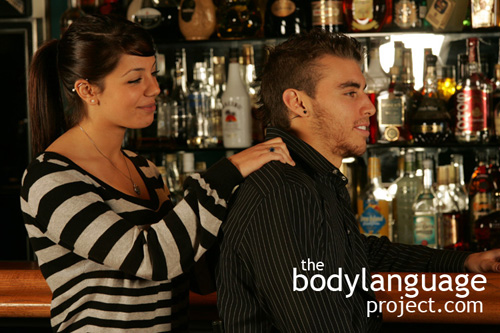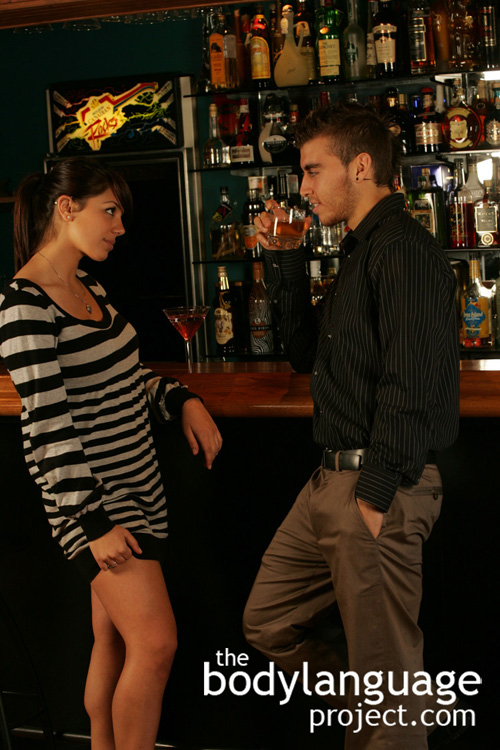Body Language of Slow Stroking Of Upper Thigh
 Cue: Slow Stroking Of Upper Thigh.
Cue: Slow Stroking Of Upper Thigh.
Synonym(s): Rubbing The Hands Slowly On Upper Thigh, Upper Thigh Stroke, Thigh Stroking, Rubbing Thighs, Massaging Thighs Slowly.
Description: The hands are slowly rubbed up and down across the top of the thighs.
In One Sentence: Rubbing the upper thigh usually signals a desire to be touched in this way or that one is rubbing the sweat from the palms.
How To Use it: Women can use this gesture to signal to men that they wish to escalate sexual intimacy. Stroking the upper thing in a skirt while making eye contact with a man, will tell him that you are aroused and wish for him to make the next move.
Context: Dating.
Verbal Translation: “I’m sexually aroused causing me to act out some of the touching I would like to experience by the hands of another.”
Variant: Women often replicate the types of touching they would like to receive. The cliché act is quite common in adult films when no male actor is present or when she tries to seduce one, or the camera. She seductively touches and strokes her own body in effort to arouse the viewer. Men are programmed to find this alluring. As they touch, women are readying the body to be touched and at the same time providing an outlet that reduces their desire to act outwardly and instead illicit male pursuit instead. Self-touching releases positive hormones in the body that produce a calming effect. See Self-Stroking or Auto Contact, Leg Cleansing or Leg Pacifying Behaviour.
Cue In Action: While making eye contact, licking her lips frequently, she seductively stroked her thighs as she was speaking to a guy at the bar.
Meaning and/or Motivation: It is common for women to perform self-touching when aroused. Self-touch is usually a signal that touching from another person is welcome but it must be accompanied by other sexual signals. Eye contact is one of the most important signals because it serves to anchor the signal to a specific person. If eye contact is absent, then the cue may simple be a broadcast signal to the room at large due to her ovulation cycle, or her level of receptivity.
When a woman rubs her thighs she is simulating the type of touching she’d like to receive and this is part of the purpose. She can produce a pacifying effect to help calm her desires, but also to draw attention to her features, her thighs, and subconsciously suggest to her desired partner what course of action she would prefer.
Men who are aware of the courtship gesture should be sure that the legs are not being stroked simply because she is performing a “leg cleansing” where she is wiping sweat from her palms or trying to gain comfort through self soothing due to nervousness. Although, at times, nervousness and courtship are intertwined.
Cue Cluster: Watch for eye contact, head down with eyes cast upward, frequent lip licking, wrist and neck exposure, exposing the inner thigh, self-stroking (other areas of the body), legs uncrossed and re-crossed, and so forth.
Body Language Category: Auto contact or self-touching, Autoerotic touching, Courtship display, Stroking body language, Indicators of sexual interest (IOsI), Tie signals.
Resources:
Abbey, A., and Melby, C. (1986). The effects of nonverbal cues on gender differences in perceptions of sexual intent. Sex Roles, 15, 283-298.
Abrahams, Matthewf. Perceiving flirtatious communication: An exploration of the perceptual dimensions underlying judgments of flirtatiousness. Journal of Sex Research. 1994. 31(4): 283-292.
Bohm. 1997. Effects of interpersonal touch, degree of justification, and sex of participant on compliance with a request. The Journal of social psychology. 137: 460-469.
Barroso, Felix ; Feld, Jason. Self-touching and attentional processes: The role of task difficulty, selection stage, and sex differences. Journal of Nonverbal Behavior. 1986. 10(1): 51-64.
Butzen, Nathan David ; Bissonnette, Victor ; Mcbrayer, Dan. Effects of modeling and topic stimulus on self-referent touching. Perceptual and motor skills. 2005. 101(2): 413-20.
Broome, Marion E.. Helping Parents Support Their Child In Pain. Pediatric Nursing. 2000. 26(3): 315.
Bornstein, Marc H. ; Tamis-Lemonda, Catherine S. Maternal responsiveness and infant mental abilities: Specific predictive relations. Infant Behavior and Development. 1997. 20(3): 283-296.
Buckley, V., & Semple, S. (2012). Evidence that displacement activities facilitate behavioural transitions in ring-tailed lemurs. Behavioural Processes, 90, 433–435.
Bernal, Gilda Rios ; Wortham, Suec. How to Calm Children through Massage. Childhood Education. 1997. 74(1): 9-14.
Bouhuys, A.L. ; Jansen, C.J. ; van den Hoofdakker, R.H. Analysis of observed behaviors displayed by depressed patients during a clinical interview: relationships between behavioral factors and clinical concepts of activation. Journal of Affective Disorders. 1991. 21(2): 79-88.
Bouhuys, A.L. ; Beersma, Domien G.M. ; van den Hoofdakker, Rutger H. Observed behavior as a predictor of the response to sleep deprivation in depressed patients. Psychiatry Research. 1989. 28(1): 47-61.
Berridge CW,Mitton E, ClarkW, Roth RH. 1999. Engagement in a non-escape (displacement) behavior elicits a selective and lateralized suppression of frontal cortical dopaminergic utilization in stress. Synapse 32:187–197.
Bond, Michael H., and Hiroshi Komai (1976). “Targets of Gazing and Eye Contact During Interviews: Effects on Japanese Nonverbal Behavior.” In Journal of Personality and Social Psychology (Vol. 34), pp. 1276-84.
Blakeslee, Sandra (1995). “In Brain’s Early Growth, Timetable Maybe Crucial.” In New York Times (“Science Times,” August 29), pp. C1, C3.
Costa, M., Menzani, M., & Ricci Bitti, P. E. Head canting in paintings: An historical study. Journal of Nonverbal Behavior. 2001. 25: 63–73.
Costa, M., & Ricci Bitti, P. E. Face-ism effect and head canting in one’s own and others’ photographs. European Psychologist. 2000. 5: 293–301.
Cari D. Goetz; Judith A. Easton; David M.G. Lewis; David M. Buss. Sexual Exploitability: Observable Cues And Their Link To Sexual Attraction. Evolution and Human Behavior. 2012; 33: 417-426.
http://bodylanguageproject.com/articles/victim-blaming-or-useful-information-in-preventing-rape-and-sexual-exploitation/
Cantú, Stephanie M ; Simpson, Jeffry A ; Griskevicius, Vladas ; Weisberg, Yanna J ; Durante, Kristina M ; Beal, Daniel J. Fertile and Selectively Flirty. Psychological Science. 2014. 25(2): 431-438.
Clark, A. Attracting Interest: Dynamic Displays of Proceptivity Increase the Attractiveness of Men and Women. Evolutionary Psychology. 2008., 6(4), 563-574.
http://bodylanguageproject.com/articles/risky-versus-proceptive-nonverbal-sexual-cues/
Clifford, Ruth. Development of Masturbation in College Women Archives of Sexual Behavior. 1978. 7(6): 559-573.
Durante, Kristina M ; Li, Norman P ; Haselton, Martie G. Changes in women’s choice of dress across the ovulatory cycle: naturalistic and laboratory task-based evidence. Personality & social psychology bulletin. 2008 34(11): 1451-60.
Dreznick, Michaelt. ; Cronin, Josephm. ; Waterman, Carolinek. ; Glasheen, Cristie. Saying Yes when Meaning No: An Investigation of Gender and Individual Differences in Token Seduction. Journal of Psychology & Human Sexuality. 2003. 15(1): 69-84.
Ekman, Paul, and Wallace V. Friesen (1969). “Nonverbal Leakage and Clues to Deception.” In Psychiatry (Vol. 32), pp. 88-106.
Fisher, J; Rytting, M and Heslin, R. 1976. Hands touching hands: affective and evaluative effects on interpersonal touch, Sociometry 39: 416–421.
Fink, Bernhard; Nadine Hugill and Benjamin P. Lange. Women’s Body Movements Are a Potential Cue to Ovulation. Personality and Individual Differences. 2012. 53: 759-763.
http://bodylanguageproject.com/articles/women-use-sexier-body-language-indicate-ovulation-fertility-women-dance-walk-sexier/
Fletcher, Garth J. O ; Kerr, Patrick S. G ; Li, Norman P ; Valentine, Katherine A. Predicting Romantic Interest and Decisions in the Very Early Stages of Mate Selection. Personality and Social Psychology Bulletin. 2014 40(4): 540-550.
Goldberg, Shelly ; Rosenthal, Robert. Self-touching behavior in the job interview: Antecedents and consequences. Journal of Nonverbal Behavior. 1986. 10(1): 65-80.
Givens D. The nonverbal basis of attraction: Flirtation, courtship, and seduction. Psychiatry. 1978. 41: 346.
Grammer, Karl ; Kruck, Kirsten ; Juette, Astrid ; Fink, Bernhard. Non-verbal behavior as courtship signals: the role of control and choice in selecting partners. Evolution and Human Behavior. 2000. 21(6): 371-390.
Grammer, Karl ; Juette, Astrid ; Schmitt, Alain ; Honda, Masanao Insko, Chester A. (editor). Fuzziness of Nonverbal Courtship Communication Unblurred by Motion Energy Detection. Journal of Personality and Social Psychology. 1999. 77(3): 487-508.
Grammer, K. (1990). Strangers meet: Laughter and nonverbal signs of interest in opposite-sex encounters. Journal of Non? verbal Behavior, 14, 209-237.
Greer, Arlettee. ; Buss, Davidm. Tactics for promoting sexual encounters. Journal of Sex Research. 1994. 31(3): 185-201.
Goetz, Cari D.; Judith A. Easton; David M.G. Lewis; David M. Buss. Sexual Exploitability: Observable Cues And Their Link To Sexual Attraction. Evolution and Human Behavior. 2012; 33: 417-426.
http://bodylanguageproject.com/articles/victim-blaming-or-useful-information-in-preventing-rape-and-sexual-exploitation/
Goetz, Cari D.; Judith A. Easton; Cindy M. Meston. The Allure of Vulnerability: Advertising Cues to Exploitability as a Signal of Sexual Accessibility. Personality and Individual Differences. 2013. 62: 121-125. http://dx.doi.org/10.1016/j.paid.2014.02.019
http://bodylanguageproject.com/articles/allure-sexual-vulnerability-move/
Guéguen, N. (2007). Courtship compliance: The effect of touch on women’s behavior. Social Influence, 2, 81-97.
Guéguen Nicolas. Gait and menstrual cycle: ovulating women use sexier gaits and walk slowly ahead of men. Gait Posture. 2012; 35(4): 621-4.
http://bodylanguageproject.com/articles/gait-as-bait-women-walk-sexy-during-high-sexual-receptivity/
Gueguen, Nicolas. The effect of a woman’s incidental tactile contact on men’s later behavior.(Report). Social Behavior and Personality: an international journal. 2010. 38(2): 257(10).
Guéguen, Nicholas. High Heels Increase Women’s Attractiveness. Archives of Sexual Behavior. 2014. DOI 10.1007/s10508-014-0422-z
http://bodylanguageproject.com/articles/high-heels-exact-power-men-study-women-wear-heels/
Guéguen, Nicolas. Color and Women Attractiveness: When Red Clothed Women Are Perceived to Have More Intense Sexual Intent. The Journal of Social Psychology, 2012; 152(3): 261–265.
http://bodylanguageproject.com/articles/men-prefer-women-who-dress-in-red-and-wear-red-lipstick-how-to-earn-more-tips-or-favours-from-men/
Guéguen, N. The Effect Of A Woman’s Smile On Men’s Courtship Behavior. Social Behavior and Personality. 2008. 36(9): 1233-1236.
http://bodylanguageproject.com/articles/how-women-can-use-a-simple-smile-to-attract-men/
Guéguen, N., & Fischer-Lokou, J. (2004). Hitchhiker’s Smiles And Receipt Of Help. Psychological Reports. 94: 756-760.
Guéguen, Nicolas. The Effect Of Women’s Suggestive Clothing On Men’s Behavior And Judgment: A Field Study. Psychological Reports. 2011. 109; 2: 635-638.
http://bodylanguageproject.com/articles/sexy-clothing-source-power-women/
Grammer, Karl, LeeAnn Renninger and Bettina Fischer. Disco Clothing, Female Sexual Motivation, and Relationship Status: Is She Dressed to Impress? The Journal of Sex Research. 2004. 41(1): 66-74.
http://bodylanguageproject.com/articles/is-she-dressed-for-success-how-women-adorn-during-courtship/
Grammer, Karl, LeeAnn Renninger and Bettina Fischer. Disco Clothing, Female Sexual Motivation, and Relationship Status: Is She Dressed to Impress? The Journal of Sex Research. 2004. 41(1): 66-74.
http://bodylanguageproject.com/articles/is-she-dressed-for-success-how-women-adorn-during-courtship/
Grammer, Karl ; Kruck, Kirsten ; Magnusson, Magnus. The Courtship Dance: Patterns of Nonverbal Synchronization in Opposite-Sex Encounters. Journal of Nonverbal Behavior, 1998, Vol.22(1), pp.3-29.
Goodboy, Alan, K. and Maria Brann. Flirtation Rejection Strategies: Towards an Understanding of Communicative Disinterest in Flirting. The Quantitative Report. 2010. 15(2): 268-278.
http://bodylanguageproject.com/articles/how-to-reject-flirting-using-nonverbal-and-verbal-tactics/
Grand, Stanley (1977). “On Hand Movements During Speech: Studies of the Role of Self-Stimulation in Communication Under Conditions of Psychopathology, Sensory Deficit, and Bilingualism.” In Norbert Freedman and Stanley Grand, eds., Communicative Structures and Psychic Structures: A Psycholanalytic Interpretation of Communication (New York: Plenum Press), pp. 199-221.
Goodall, Jane (1986). The Chimpanzees of Gombe: Patterns of Behavior (Cambridge: Belknap Press of Harvard University).
Givens, David B. (1976). An Ethological Approach to the Study of Human Nonverbal Communication (University of Washington Ph.D. dissertation in Anthropology, Ann Arbor: University Microfilms).
Grand, Stanley (1977). “On Hand Movements During Speech: Studies of the Role of Self-Stimulation in Communication Under Conditions of Psychopathology, Sensory Deficit, and Bilingualism.” In Norbert Freedman and Stanley Grand, eds., Communicative Structures and Psychic Structures: A Psycholanalytic Interpretation of Communication (New York: Plenum Press), pp. 199-221.
Harrigan, Jinni A.; Karen S. Lucic; Denise Kay; Anne McLaney and Robert Rosenthal. Effect of Expresser Role and Type of Self-Touching on Observers’ Perceptions. Journal of Applied Social Psychology. 1991. 21(7): 585-609.
Heaven, L ; Mcbrayer, D. External motivators of self-touching behavior. Perceptual and motor skills. 2000. 90(1): 338-42.
Heaven, Laura ; Mcbrayer, Dan ; Prince, Bob. Role of sex in externally motivated self-touching gestures. Perceptual and motor skills. 2002. 95(1): 289-94.
Hall, Jeffrey A. and Chong Xing. The Verbal and Nonverbal Correlates of the Five Flirting Styles. Journal of Nonverbal Behavior. 2015. 39:41–68. DOI 10.1007/s10919-014-0199-8
http://bodylanguageproject.com/articles/first-12-minutes-flirting-using-nonverbal-communication-study-reveals-26-body-language-cues-attraction/
Hugill, Nadine ; Fink, Bernhard ; Neave, Nick. The role of human body movements in mate selection. Evolutionary psychology: an international journal of evolutionary approaches to psychology and behavior. 2010 8(1): 66-89.
Hernandez-Reif, Maria ; Diego, Miguel ; Field, Tiffany. Preterm infants show reduced stress behaviors and activity after 5 days of massage therapy. Infant Behavior and Development. 2007. 30(4): 557-561.
Harrison, Lynda Law. The use of comforting touch and massage to reduce stress for preterm infants in the neonatal intensive care unit. Newborn and Infant Nursing Reviews. 2001. 1(4): 235-241.
Hennessy, Michael B ; T. Williams, Michael ; Miller, Deborah D ; Douglas, Chet W ; Voith, Victoria L. Influence of male and female petters on plasma cortisol and behaviour: can human interaction reduce the stress of dogs in a public animal shelter?
Applied Animal Behaviour Science. 1998. 61(1): 63-77.
Harrigan, Jinni A. Self-touching as an indicator of underlying affect and language processes. Social Science & Medicine. 1985. 20(11): 1161-1168.
Harrigan, Jinni A.; Karen S. Lucic; Denise Kay; Anne McLaney and Robert Rosenthal. Effect of Expresser Role and Type of Self-Touching on Observers’ Perceptions. Journal of Applied Social Psychology. 1991. 21(7): 585-609.
Heaven, Laura ; Mcbrayer, Dan ; Prince, Bob. Role of sex in externally motivated self-touching gestures. Perceptual and motor skills. 2002. 95(1): 289-94.
Heaven, L ; Mcbrayer, D. External motivators of self-touching behavior. Perceptual and motor skills. 2000. 90(1): 338-42.
Juni, Samuel ; Cohen, Phyllis. Partial impulse erogeneity as a function of fixation and object relations. Journal of Sex Research. 1985. 21(3): 275-291.
Kenner, Andrew N. (1993). “A Cross-Cultural Study of Body-Focused Hand Movement.” In Journal of Nonverbal Behavior (Vol. 17, No. 4, Winter), pp. 263-79.
Kellerman. 1989. Looking and loving: The effects of mutual gaze on feelings of romantic love. Journal of Research in Personality. 23(2): 145-161.
Keltner, D. The signs of appeasement: Evidence for the distinct displays of embarrassment, amusement, and shame. Journal of Personality and Social Psychology. 1995. 68: 441–454.
Krumhuber, Eva; Antony S. R.; Manstead; and Arvid Kappas. Temporal Aspects of Facial Displays in Person and Expression Perception: The Effects of Smile Dynamics, Head-tilt, and Gender. Journal Nonverbal Behavior. 2007; 31: 39-56.
DOI 10.1007/s10919-006-0019-x
http://bodylanguageproject.com/articles/head-tilt-and-slow-onset-smile-nonverbals-trust-attraction-dominance-and-flirting-a-brief-report/
Kammers, Marjolein P.M. ; de Vignemont, Frédérique ; Haggard, Patrick. Cooling the Thermal Grill Illusion through Self-Touch. Current Biology. 2010. 20(20): 1819-182.
Kammers, Marjolein P.M. ; de Vignemont, Frédérique ; Haggard, Patrick. Cooling the Thermal Grill Illusion through Self-Touch. Current Biology. 2010. 20(20): 1819-182.
Lynch, A. Expanding the Definition of Provocative Dress: An Examination of Female Flashing Behavior on a College Campus. Clothing and Textiles Research Journal. 2007. 25(2): 184-201.
Lockard, J.S., Adams, R.M. Courtship behaviors in public: Different age/sex roles. Ethology and Sociobiology l(3): 245-253 (1980).
Maclaren, Kym. Touching matters: Embodiments of intimacy. Emotion, Space and Society. 2014. 13: 95-102.
Martens, Jason P.; Jessica L. Tracy and Azim F. Shariff. Status signals: Adaptive
benefits of displaying and observing the nonverbal expressions of pride and shame, Cognition & Emotion. 2012. 26(3): 390-406. DOI: 10.1080/02699931.2011.645281
http://bodylanguageproject.com/articles/significant-nonverbal-expression-pride-shame-body-language-detailed-examination-origin-function/
Martina Mara and Markus Appel. Effects of Lateral Head Tilt on User Perceptions of Humanoid and Android Robots. Computers in Human Behavior. 2015. 44: 326-334
http://bodylanguageproject.com/articles/nonverbal-head-tilt-says-robot/
Moore, Monicam. Human Nonverbal Courtship Behavior—A Brief Historical Review. Journal of Sex Research. 2010 47(2-3): 171-180.
Moore, Monica. Courtship Signaling and Adolescents: Girls Just Wanna Have Fun. Journal of Sex Research. 1995. 32(4): 319-328.
http://bodylanguageproject.com/articles/girls-just-want-to-have-fun-the-origins-of-courtship-cues-in-girls-and-women/
Moore, Monica. M. Nonverbal Courtship Patterns in Women: Context and consequences. Ethology and Sociobiology. 1985. 6:237- 247.
Moore, M. M. Courtship Communication and Perception. Perceptual and Motor Skills. 2002. 94(1): 97-105. doi:10.2466/PMS.94.1.97-105.
Moore, M. M. and D. L. Butler. 1989. Predictive aspects of nonverbal courtship behavior in women. Semiotica 76(3/4): 205-215.
Moore, M. M. 2001. Flirting. In C. G. Waugh (Ed.) Let’s talk: A cognitive skills approach to interpersonal communication. Newark, Kendall-Hunt.
Mishra, Sandeep; Andrew Clark and Martin Daly. One Woman’s Behavior Affects The Attractiveness Of Others. Evolution and Human Behavior. 2007 28: 145-149.
http://bodylanguageproject.com/articles/rival-good-body-language-makes-partner-look-uglier/
Morris, Paul H.; Jenny White, Edward R. Morrison and Kayleigh Fisher. High Heels As Supernormal Stimuli: How Wearing High Heels Affects Judgements of Female Attractiveness. Evolution and Human Behavior. 2013. 34: 176-181.
http://bodylanguageproject.com/articles/high-heels-supernormal-body-language-signal
Markey, Patrick ; Markey, Charlotte. Changes in women’s interpersonal styles across the menstrual cycle. Journal of Research in Personality. 2011. 45(5): 493-499.
Miller, G., Tybur, J. M., & Jordan, B. D. Ovulatory cycle effects on tip earning by lap dancers: Economic evidence for human estrus. Evolution and Human Behavior. 2007. 28: 375-381.
McCormick, Naomi B. and Andrew J. Jones. Gender Differences in Nonverbal Flirtation. Journal of Sex Education and Therapy. 1989. 15(4): 271-282.
Maestripieri D, Schino G, Aureli F, Troisi A. 1992. A modest proposal: displacement activities as an indicator of emotions in primates. Anim Behav 44:967–979.
Mohiyeddini, C., Bauer, S., & Semple, S. (2013a). Displacement behaviour is associated with reduced stress levels among men but not women. PLoS One, 8, e56355.
Mohiyeddini, C., Bauer, S., & Semple, S. (2013b). Public self-consciousness moderates the link between displacement behaviour and experience of stress in women. Stress, 16, 384–392.
Mohiyeddini, C., & Semple, S. (2013). Displacement behaviour regulates the experience of stress in men. Stress, 16, 163–171.
Morris, Desmond (1994). Bodytalk: The Meaning of Human Gestures (New York: Crown Publishers).
McGrew, W. C. (1972). “Aspects of Social Development in Nursery School Children with Emphasis on Introduction to the Group.” In N. G. Blurton Jones, ed., Ethological Studies of Child Behaviour (Cambridge: University Press), pp. 129-56.
Nelson, Holly ; Geher, Glenn. Mutual Grooming in Human Dyadic Relationships: An Ethological Perspective. Current Psychology. 2007. 26(2): 121-140.
O’Sullivan, Luciaf. ; Byers, E. Sandra. Eroding stereotypes: College women’s attempts to influence reluctant male sexual partners. Journal of Sex Research. 1993 30(3): 270-282.
Perper, T., and Weis, D. L. (1987). Proceptive and rejective strategies of U. S. and Canadian college women. The Journal of Sex Research, 23, 455-480.
Paulsell, Shari ; Goldman, Morton. The Effect of Touching Different Body Areas on Prosocial Behavior. The Journal of Social Psychology. 1984. 122(2): 269-273.
Petrican, Raluca; Christopher T. Burris and Morris Moscovitch. Shame, Sexual Compulsivity, and Eroticizing Flirtatious Others: An Experimental Study. Journal of Sex Research. 2015. 52(1), 98–109, 2015. DOI: 10.1080/00224499.2013.829796
http://bodylanguageproject.com/articles/coy-flirtatious-smile-eye-contact-leads-shame-sex/
Pugh, George E. (1977). The Biological Origin of Human Values (New York: Basic Books).
Rosenfeld, Howard (1973). “Nonverbal Reciprocation of Approval: An Experimental Analysis.” In Argyle *, pp. 163-72.
Remland, M. S. and T. S. Jones 1995. Interpersonal Distance, Body Orientation, and Touch: Effects of Culture, Gender, and Age. Journal of Social Psychology 135(3): 281-297.
Peck, J., & Shu, S. B. (2009). The effect of mere touch on perceived ownership. Journal of Consumer Research, 36(Oct), 434–447.
Riskind, John H. Manis, Melvin (editor). They stoop to conquer: Guiding and self-regulatory functions of physical posture after success and failure. Journal of Personality and Social Psychology. 1984 47(3): 479-493.
Sommer, Robert (1969). Personal Space: The Behavioral Basis of Design (Englewood Cliffs, New Jersey: Prentice-Hall).
Shotland, L. R., & Craig, J. M. (1988). Can men and women differentiate between friendly and sexually interested behavior? Social Psychology Quarterly, 51, 66-73.
Schreiber, Clements, Michelee. ; Rempel, Johnk. ; Desmarais, Serge. Women’s sexual pressure tactics and adherence to related attitudes: A step toward prediction. Journal of Sex Research. 1998 35(2): 197-205.
Tracy, Jessica L. and David Matsumoto. The Spontaneous Expression Of Pride And Shame: Evidence For Biologically Innate Nonverbal Displays. 2008; 105 (33) 11655-11660.
http://bodylanguageproject.com/articles/universal-expressions-of-pride-and-shame/
Tracy, Jessica L. and Alec T. Beall. Happy Guys Finish Last: The Impact of Emotion Expressions on Sexual Attraction Emotion. American Psychological Association. 2011; 11(6): 1379–1387
http://bodylanguageproject.com/articles/happy-guys-finish-last-happy-women-finish-first-says-new-study-on-sexual-attractiveness/
Theiss, Jennifera. ; Solomon, Denise Haunani. Communication and the Emotional, Cognitive, and Relational Consequences of First Sexual Encounters between Partners. Communication Quarterly. 2007. 55(2): 179-206.
Walsh, D. G., & Hewitt, J. (1985). Giving Men The Come-On: Effect Of Eye Contact And Smiling In A Bar Environment. Perceptual and Motor Skills, 61, 873-874.
Weerth, Carolina ; Kalma, Akko. Gender differences in awareness of courtship initiation tactics. Sex Roles. 1995. 32(11): 717-734.
Willis, Frank N. , Jr. ; Dodds, Rebecca A. Age, relationship, and touch initiation. The Journal of Social Psychology. 1998. 138(1). 115(9).





